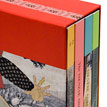 |
 |
 |
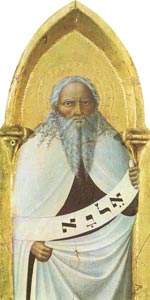 |
 |
Sassetta, The
Prophet Elijah,
tempera and gold on wood,
7 1/2 x 21 1/2 inches,
Pinacoteca Nazionale, Siena. |
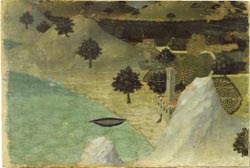 |
 |
Sassetta, Landscape,
tempera on wood,
8 5/8 x 12 5/8 inches,
Pinacoteca Nazionale, Siena.
Photo credit: Scala/Art Resource, NY |
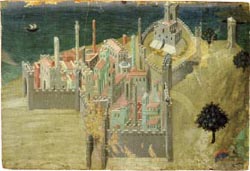 |
 |
Sassetta, Landscape,
tempera on wood,
9 x 13 inches,
Pinacoteca Nazionale, Siena.
Photo credit: Scala/Art Resource, NY |
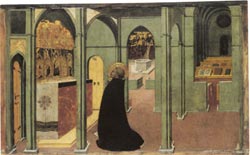 |
 |
Sassetta, Saint Thomas
Aquinas in Prayer,
tempera and gold on wood,
9 1/2 x 15 inches,
Museum of Fine Arts,
Budapest. |
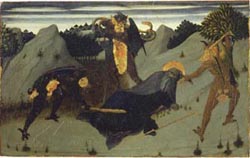 |
 |
Sassetta, Landscape,
tempera on wood,
9 x 13 inches,
Pinacoteca Nazionale, Siena.
Photo credit: Scala/Art Resource, NY |
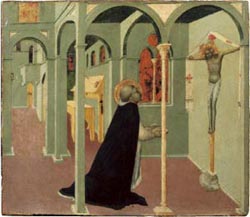 |
 |
Sassetta, The Vision of
Saint Thomas Aquinas,
tempera and gold on wood,
9 7/8 x 11 3/8 inches,
Vatican Museums,
Vatican City.
Photo credit: Scala/Art Resource, NY |
|
 |
 |
|
 |
 |
| Trevor Winkfield |
The Early Sassetta |
Sassetta was a painter of fragments. Or rather, as we perceive him today,
he
is a painter of fragments. The dismantling, dismembering and diaspora of
his altarpieces, together with their physical abrasions, fadings, candle
smoke stainings, restorations, excessive cleanings and varnishings have
left
us with an array of objects which can bear little relation to what people
must have seen during Sassetta’s lifetime. Posterity’s paring
of Uccello’s
oeuvre seems lenient by comparison.
Sassetta himself is a man of fragments, none of which add up to a solid
portrait. We’re in the position of those hapless archaeologists trying
to
reconstruct a vase based on slivers of crumbling handles. Sassetta is as
lost
to us as those anonymous craftsmen who erected cathedral towers. The few
biographical facts to be garnered from the archives offer little more than
a
ghost of a profile: his body is missing, the personality remains a riddle.
No
temper tantrums with Popes or severed ears can be traced to him. Like
reading shards, the profile has to be fleshed out using the surviving paintings.
(Though we should keep in mind that in all instances not only is the
painting more important than the painter, in a perfect fusion the painting
is the painter.)
It should at the outset be observed that the painter we behold today differs
considerably not only from the painter seen by his contemporaries, but
also from the painter who was first extricated from historical obscurity
a
century ago. Fascination with his work has steadily increased in relation
to
the number of art movements his reputation has been subsequently filtered
through. Transmitted via the distorting lens of Cubism, Surrealism,
Abstraction, Pop Art and Minimalism (not forgetting comic strips and
Technicolor), he now appears, along with Giovanni di Paolo and Paolo
Uccello, as one of the most idiosyncratic and yet most profound painters
of
the Quattrocento period, one of those talents with most to offer present-day
viewers and artists. (On the other hand, the cumulative effects of those
very
same movements which renewed interest in Sassetta have, by contrast, rendered
Raphael’s influence all but harmless.)
Quite literally, we see neither the spectrum nor space (let alone religion)
as our predecessors saw them during the Dark Centuries preceding
Impressionism. Sassetta has been one of the beneficiaries of the twentieth
century’s brightenings and flattenings—and, let’s note,
its parallel embracing,
absorption and abandonment of the concept of “Primitive.” As
a result,
he and his Sienese kin now feel closer to us than the Barbizon School.
“Could it be that at the center of Sassetta’s art there lay no
core of sodden
sentimentalism but an original and virile mind?” So wrote John Pope-Hennessy
somewhat uncertainly in his eximious 1939 disquisition on the artist. But
just as there has been a pictorial revolution over the past century, so
in the gap between Pope-Hennessy’s query and our own time there
has been a quickening aversion towards purely formal dissections of a
painter’s worth, a reaction to a clapped-out academic modernism, particularly
in its abstract branches.
Without a hint of embarrassment, previously squirm-inducing designations
such as “charm,” “delightful,” “mythopoeic,” “lovely,” “toylike,”
even Pope-Hennessy’s “sentimentalism” have begun to vivify—or
muddy,
depending on one’s stance—the aesthetic waters for the first
time since
Victorian days, adjectives no longer cast as epithets but as locations of
interest.
Not that Sassetta lacked classic skills in picture making: serenity, harmony
and balance he had in abundance. No mere oddball he. But his career
stands as one more riposte to the widespread belief that only formalists
have long creative lives. Visionaries too can have longevity. Today, when
individualism is a trait prized above all others, there’s another point
in
Sassetta’s favor: he looks as though he were painting for himself and
not
only for the clergy or wealthy patrons. He was painting for them, of course,
but cleverly disguised this necessity. And it—the work—was all
laid down
before the aloof cleverness of the Renaissance stiffened bristles throughout
Italy, at a time when fervid imaginations still granted improvisation a starring
role in design.
—
TREVOR WINKFIELD exhibits his paintings at Tibor de Nagy Gallery in
New
York City. Trevor Winkfield’s Drawings was recently published
by Bamberger
Books. The present text on Sassetta is the first part of a book in progress.
For more
information go to trevorwinkfield.com.
For the complete article purchase The Sienese Shredder #1
Also by Trevor Winkfield
Daubs of Late
Lubin Baugin
Back to The Sienese Shredder #1
|  |
 |
 |
|
